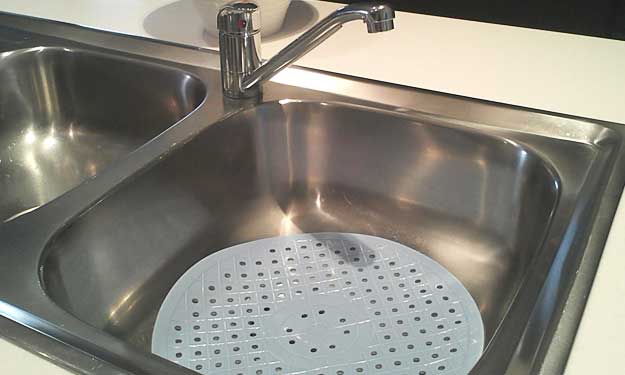How to Clean a Stainless Steel Sink

Cleaning a Stainless Steel Sink
Stainless steel is a very durable metal made from chromium and iron. It has a natural resistance to rust and staining, but that doesn’t mean you don’t have to take care of it. A stainless steel sink is a great complement to other stainless steel appliances and a beautiful addition to give your kitchen a modern and attractive look.
And when properly taken care of, scratches and most types of stains can be easy to clean. Once you know how to clean a stainless steel sink, you’ll wonder why you didn’t replace your ceramic sink earlier.
Things you Should Know Before Cleaning a Stainless Steel Sink
- Abrasive Cleaners: Stainless steel is polished and will scratch if cleaned improperly with gritty or abrasive cleaning products and scratches are permanent.
- Steel Wool or Brushes: As with using abrasive cleaners stainless steel is polished and steel wool or wire brushes will scratch the surface and do permanent damage to the sink.
- Bleach/Chlorine/Chloride: Household bleach whether straight from the jug or as an ingredient in cleaning products cause a chemical reaction to happen on the stainless steel itself. The bleach causes the steel to oxidize leaving you with a golden or grayish colored stain. And, once again the damage is permanent.
- Always Rinse Sink Thoroughly: You’re ahead of the game if you always rinse the sink completely after cleaning it or using it. Not only will it stop any wayward cleaning chemicals from causing problems, a properly rinsed sink will have less gunk you need to scrub off later.
- Scrub With the Grain, Not Against It: Polished stainless steel has a grain that you can see. It’s the direction that the polishing disk was rotating when the sink was being finished at the factory. Always scrub in the same direction as the polishing disk was going (with the grain) rather than against it or even in a haphazard circular motion. Not following the grain (or using harsh abrasives, or steel wool) can result in unsightly scratches on the stainless steel finish.
Regular Cleaning of Stainless Steel Sinks
If your sink is only in need of a light cleaning, fill it with hot water. Add several drops of dishwashing soap (Dawn works great if the sink has grease in it or if you’ve recently rinsed poultry) while the water is running to build some suds.
If you’re going to put your hands in the water, wear gloves to protect them from the hot water. Once the suds have reached the top of the sink turn the water off and use a soft nylon brush or a soft cloth to clean all four sides and the bottom of the sink. When you’ve done this, let the water drain and rinse it with cool water.
To disinfect, pour distilled white vinegar on a cloth or paper towel and wipe out the sink then dry with a soft cloth.
How to Heavy Duty Clean a Stainless Steel Sink
If there’s food or grease clinging to your sink, you can try softening it by adding a little dish liquid and letting it sit about 15 to 20 minutes. If there is still stuck on food, sprinkle some baking soda in the sink and scrub (with the grain) gently with a wet sponge (make sure the sponge is wet, you do not want to scratch the sink).
Baking soda provides a way to clean a stainless steel sink naturally, it’s also a natural deodorizer so the sink will smell fresh when it’s done too. Rinse with clean water.
Baking soda can also help remove rust stains from a stainless steel sink.
Removing Stains from Stainless Steel
If you have cream of tartar you can use it along with hydrogen peroxide to clean the sink. Here’s how to clean and remove stains with these two natural ingredients:
- Add three parts cream of tartar to one part hydrogen peroxide.
- Depending on the size of your sink, start with 3 tablespoons cream of tartar and 1 tablespoon hydrogen peroxide.
- Dip a cloth into the solution and rub it around the sink in the direction of the grain.
- Rinse and dry sink when finished.
You can also purchase a commercial polish made especially for stainless steel. Be sure to read the directions carefully and use only a cleanser that is safe for stainless steel. Although very durable, stainless is vulnerable to scratching and the shiny finish you love so much could be ruined if you use the wrong cleaners.
Shining and Removing Streaks on Stainless Steel
If you have a lemon in the refrigerator that’s a day or two from being tossed, don’t throw it away. Cut it in half and rub the cut ends on the sink after you’ve cleaned it. Not only will the lemon make the sink shine, it will add a fresh, clean lemon scent to the kitchen.
You can also keep stainless steel clean and shiny by applying baby oil. Just use a clean soft cloth and wipe down the sink.
Maintaining Stainless Steel
Here are a few things that can be done to keep your stainless steel sink looking good:
- Use a raised mat to keep utensils, dishes and pots and pans off the bottom of the sink. Mats come in rubber or metal. If you opt for a rubber mat, you may have to lift it to rinse trapped food.
- If you keep sponges and other cleaning supplies in the sink, use a plastic container, a sink caddy or other holder for keeping these items off the surface of the stainless steel.
- Rinse and dry the sink after each use to prevent water marks.
- Avoid harsh chemicals.



